Peel and stick tile backsplash has a lot of advantages and in the last few years, many homeowners have chosen to install a peel and stick backsplash over their existing tile. While this is an attractive choice, the process of installing it can be time-consuming. Read on to learn how to properly install a peel and stick tile backsplash. Once installed, the tiles are easy to remove and reposition. For the best results, prepare the backsplash surface with water. After rinsing it thoroughly, apply a second coat of sealant to prevent it from cracking.
Cost of peel and stick backsplash over tile
If you’re remodeling your old kitchen, and do not want to damage your walls, you might be interested in the peel and stick backsplash over tiles. Then you will wondering about the cost, while the product may seem simple, it does have some cons. It is also easy to remove and comes in a variety of materials, including vinyl, silica gel, and real mosaic tiles. However, if you’re in a pinch, you can always opt for a cheaper option like vinyl. The price of eight panels of vinyl peel and stick tiles starts at $5.
The price of peel and stick backsplash over tile varies, depending on the quality of the product you choose. Generally, lower-grade peel-and-stick products cost $3 to $7 per square foot, while more expensive versions can cost up to $30. While these are a great option if you want to save money and install a backsplash yourself, they’re not as durable as tile or other traditional options. Therefore, if you’re planning on moving or selling your home in the near future, you might want to reconsider the cost of this type of backsplash.
Time it takes to install
If you are looking for a way to update the look of your kitchen, you might consider using a peel and stick backsplash over tile. This type of backsplash requires little to no effort and can be installed quickly and cheaply. It is important to measure the area of the backsplash, cut the tiles to size, and adhere them to the surface. Some DIYers will flex, press, and bend the tiles when they are in place. Be careful not to use too much force or else the tiles may be stretched.
When you choose a peel and stick backsplash, you can choose the color that matches the rest of your kitchen’s decor. These tiles are made of vinyl, silica gel, or thin natural materials. The ones that have a plastic sheen can be purchased online. If you’re working with an existing tile backsplash, you can also paint it to resemble marble. For a budget-friendly update, you can choose to build a pantry, install RTA cabinets, or even paint the kitchen island to look like marble.
Styles of tiles available
You have many different styles of peel and stick backsplash tiles to choose from. There are tiles made from PVC, vinyl, glass, quartz, and even ceramic. Each type has different qualities, such as durability, weight, and resistance to water and heat. In addition, you should consider the material’s resistance to wear and tear. Listed below are some examples of the styles of tiles available for your backsplash. Read on to discover what’s right for you.
A peel and stick backsplash is simple to install. However, you should ensure that the area is clean before you apply the tiles. You can use a mild cleaning solution to clean the surface of the wall, removing any dirt or gunk. Make sure to allow it to dry completely before installing the tiles. Tiles that stick well to a wall require a dry surface. The cost of a peel and stick backsplash kit is approximately $25 per square foot.
Repositionability of tiles
While peel and stick tiles are relatively easy to cut with a utility knife, you should make a template first to ensure you get the correct placement for your backsplash. You can cut a sheet of paper to the exact measurement of the spot you want to cover with the tiles and transfer it to the panel. If the material is thick, you may want to use aviation snips to cut the tiles without damaging the panel behind.
Conclusion
Another advantage of a peel and stick backsplash is its ease of installation. In addition to being easy to install, peel and stick backsplash tiles can be repositioned and removed as needed. Simply peel the tile from its backing and stick it to the wall. If you need to move a tile around, you can mist the adhesive with soapy water and adjust the placement. This option is particularly convenient if you need to move a tile around or change its position.

